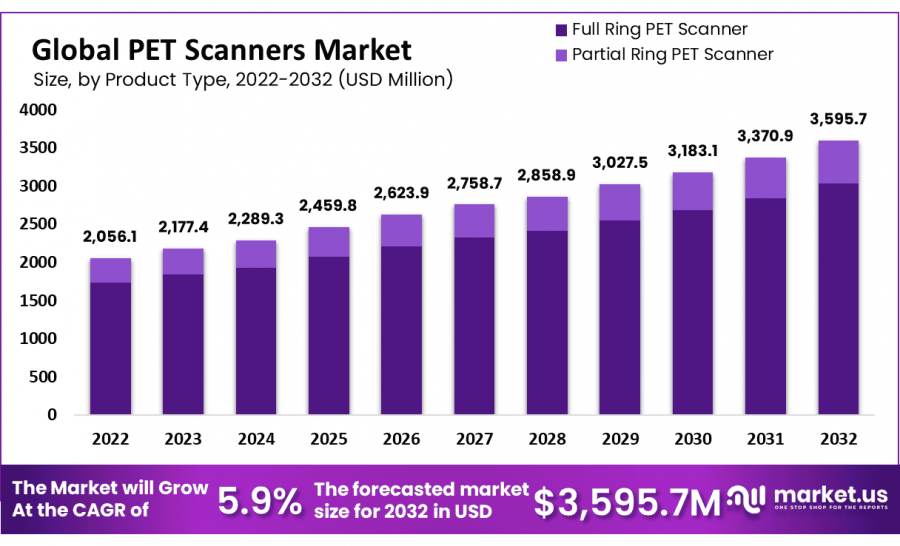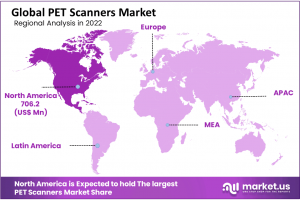
PET Scanners Market Set For Strong Growth, Projected To Reach USD 3,595.7 Million By 2032
Global Pet Scanners Market size is expected to be worth around USD 3,595.7 Million by 2032 from USD 2177.4 Million in 2023, growing at a CAGR of 5.9%
NEW YORK, NY, UNITED STATES, February 4, 2025 /EINPresswire.com/ -- Report Overview
Global Pet Scanners Market size is expected to be worth around USD 3,595.7 Million by 2032 from USD 2177.4 Million in 2023, growing at a CAGR of 5.9% during the forecast period from 2023 to 2032.
Positron Emission Tomography (PET scanners) are cutting-edge imaging devices that provide detailed, real-time visualization of metabolic and biochemical processes within the body. These scanners are crucial for diagnosing and monitoring conditions such as cancer, neurological disorders, and cardiovascular diseases, enabling early detection and precise treatment planning.
PET scanners work by using radioactive tracers to highlight abnormal cellular activity, offering greater accuracy than conventional imaging techniques. They are widely used in oncology, neurology, and cardiology, helping healthcare professionals assess disease progression and treatment effectiveness.
Advancements in hybrid imaging technologies, such as PET-CT and PET-MRI, are enhancing diagnostic capabilities, improving resolution, and reducing scan times. The growing demand for early disease detection and increasing adoption of AI-powered imaging solutions are driving market expansion. With continuous improvements in imaging technology, PET scanners remain essential tools in modern medical diagnostics. For more information, consult a healthcare provider or visit a trusted medical organization’s website.
This annual report offers a comprehensive analysis of the global PET Scanners market, providing valuable insights into future developments. By evaluating the historical and current dynamics of the PET Scanners industry, the report includes a detailed forecast to inform key stakeholders. The PET Scanners market report is designed to assist businesses in identifying and capitalizing on opportunities, while understanding key drivers, restraints, risks, and emerging trends. It also explores how time-sensitive factors impact the market under varying assumptions.
Unlock Competitive Advantages With Our PDF Sample Report https://market.us/report/pet-scanners-market/request-sample/
Key Takeaways
- Market Growth: The PET scanner market is rapidly expanding, driven by increasing demand for non-invasive diagnostic imaging, technological innovations, and applications beyond cancer detection.
- Diverse Applications: PET scanners are crucial in oncology for cancer detection, staging, and treatment monitoring. They are also used in neurology for brain function analysis and cardiology for myocardial perfusion assessment.
- Hybrid Imaging Advancements: PET/CT and PET/MRI systems combine anatomical and functional imaging, enhancing diagnostic accuracy and expanding clinical applications.
- Role of Radiopharmaceuticals: PET imaging relies on radioactive tracers injected into the body, with specific tracers chosen based on the diagnostic requirement.
- Technological Innovations: Advancements in PET scanner technology have led to higher image resolution, reduced radiation exposure, and faster scan times. Time-of-Flight (TOF) PET scanners further enhance imaging precision.
- Emerging Tracers: Ongoing R&D efforts are introducing new radiopharmaceutical tracers capable of detecting specific disease markers, expanding PET imaging applications in various medical fields.
Scope of the Report:
The global PET Scannersindustry report provides insights into production, consumption, and revenue data across various regions. This research report offers a comprehensive market evaluation, covering future trends, growth drivers, key insights, and verified industry data. It also highlights market share and growth rates across major regions.
Key market players and manufacturers are included in the report, offering a detailed analysis of industry trends and strategic developments. The findings enhance market understanding, enabling informed decisions related to geographical expansion, capacity growth, and new opportunities. The primary market drivers focus on global business expansion. Additionally, the report presents trends, advancements, material insights, technological developments, and the evolving market structure.
Key Highlights of the PET Scanners Market Study
The insights presented in this report offer critical statistical data and key figures, enabling stakeholders to evaluate market trends, strategize effectively, and enhance their competitive ranking. Researchers have conducted a thorough Strengths, Weaknesses, Opportunities, Threats (SWOT) analysis, along with identifying major challenges to provide a comprehensive market assessment. Additionally, experts have utilized PESTEL analysis and Porter’s Five Forces framework to examine external market influences. By combining quantitative and qualitative research approaches, this study provides a deeper understanding of the PET Scanners market, helping businesses establish a strong market presence.
Market Segments:
By Product Type
•Full Ring PET Scanner
•Partial Ring PET Scanner
By Modality
•PET-CT
•PET-MRI
By Application
•Oncology
•Cardiology
•Neurology
•Other Applications
By Detector Type
•Bismuth Germanium Oxide (BGO)
•Lutetium Oxyorthosilicate (LSO)
•Gadolinium Oxyorthosilicate (GSO)
•Lutetium Fine Silicate (LFS)
•Lutetium Yttrium Orthosilicate
By End-User
•Hospitals and Clinics
•Diagnostic Centres
•PET Centres
•Research Institutes
Buy This Premium Research Report@ https://market.us/purchase-report/?report_id=103328
Market Dynamics
Driver: The rising prevalence of chronic diseases, such as cancer and cardiovascular disorders, has led to an increased demand for non-invasive diagnostic tools like Positron Emission Tomography (PET) scanners. PET imaging provides detailed insights into metabolic and biochemical processes, facilitating early detection and precise disease characterization. This non-invasive approach enhances patient comfort and reduces the risks associated with more invasive diagnostic procedures. Consequently, healthcare providers are increasingly adopting PET technology to improve diagnostic accuracy and patient outcomes.
Trend: A significant trend in the PET scanner market is the integration of hybrid imaging systems, such as PET/CT and PET/MRI. These systems combine the functional imaging capabilities of PET with the anatomical detail provided by CT or MRI, offering comprehensive diagnostic information. This fusion enhances the accuracy of disease detection, staging, and treatment monitoring, particularly in oncology, neurology, and cardiology. The adoption of hybrid systems reflects a move towards more precise and personalized medical imaging solutions.
Restraint: Despite their diagnostic advantages, PET scanners involve substantial operational and maintenance costs. The need for specialized facilities, regular maintenance, and the production of short-lived radiopharmaceuticals contribute to the overall expense. These financial considerations can limit the adoption of PET technology, especially in healthcare settings with constrained budgets or in low-resource regions. Efforts to develop cost-effective solutions and streamline operations are essential to overcome this barrier.
Opportunity: Advancements in radiopharmaceutical research present significant opportunities for the PET scanner market. The development of novel radiotracers enables the visualization of specific molecular targets, expanding the applications of PET imaging beyond traditional areas. For instance, new tracers are being investigated for their potential in detecting early-stage neurodegenerative diseases and assessing tumor biology more precisely. These innovations can enhance the diagnostic utility of PET scanners and open new avenues in personalized medicine.
Key Objectives Of The PET Scanners Global Market:
• To analyze the global PET Scanners market consumption, industry size estimation, and forecast.
• To understand the general trends of the global PET Scanners market by understanding its segments and sub-segments.
• Focuses on the leading manufacturers of the Global PET Scanners market to analyze, describe and develop the company's share, revenue, market value, and competitive landscape of the company over the years.
• To analyze the PET Scanners market in terms of upcoming prospects, various growth trends, and their contribution to the international market.
• To analyze the production/consumption analysis of the global PET Scanners market with respect to key regions.
• To get detailed statistics about the key factors governing the growth potential of the global PET Scanners market.
Key Market Players:
•General Electric Company
•Hitachi Ltd.
•Koninklijke Philips N.V.
•Mediso Ltd.
•PerkinElmer, Inc.
•Positron Corporation
•Shimadzu Corporation
•Siemens AG
•Toshiba Corporation
•Yangzhou Kindsway Biotech Co. Ltd
•Other Key Players
Regional Analysis:
• North America (Panama, Mexico, Barbados, United States, Canada, Puerto Rico, Trinidad, and Tobago, etc).
• South and Central America (Brazil, Chile, Argentina, Belize, Costa Rica, Panama, Guatemala, El Salvador).
• Europe (Spain, Belgium, France, Holland, Germany, Sweden, Switzerland, San Marino, Ireland, Norway, Luxembourg, etc).
• Asia-Pacific (Qatar, China, India, Hong Kong, Korea, Israel, Australia, Singapore, Japan, Kuwait, Brunei, etc.).
• The Middle East and Africa (United Arab Emirates, Egypt, Algeria, Nigeria, South Africa, Angola, Saudi Arabia, Bahrain, Oman, Turkey, Lebanon, etc.).
Key questions answered in the report include:
• What are the key factors driving the PET Scanners market?
• What was the size of the Emerging PET Scanners Market in 2024?
• What will be the size of the Emerging PET Scanners Market in 2033?
• Which region is projected to hold the highest market share in the PET Scanners market?
• What is the market size and forecast of the global PET Scanners market?
• What products/segments/applications/areas will be invested in the Global PET Scannerss Market during the forecast period?
• What are the technological trends and regulatory framework of the Global PET Scanners market?
• What is the market share of the key vendors in the global PET Scanners market?
• What are the right modes and strategic moves to enter the Global PET Scanners Market?
Reasons to Acquire This Report
- Provides a comprehensive industry outlook, covering global market trends and high-growth segments.
- Includes market share analysis of leading players, company profiles, and critical industry insights.
- Identifies emerging trends, high-growth regions, and market drivers, restraints, and opportunities.
- Examines the latest technological advancements and innovations across various industries.
- Estimates current market size and future growth potential across key applications and industries.
Lawrence John
Prudour
+91 91308 55334
email us here
Distribution channels: Healthcare & Pharmaceuticals Industry
Legal Disclaimer:
EIN Presswire provides this news content "as is" without warranty of any kind. We do not accept any responsibility or liability for the accuracy, content, images, videos, licenses, completeness, legality, or reliability of the information contained in this article. If you have any complaints or copyright issues related to this article, kindly contact the author above.
Submit your press release


